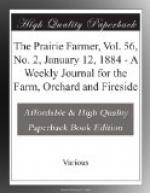THE PRAIRIE FARMER will be very glad if its readers will favor it with their ideas and the results of their observations in regard to the damage of all sorts done by the intense cold of the first week of the year.
QUESTIONS ANSWERED.
William Miller and F. Myrick, Peotone, Ill.—1. What are the laws in regard to drainage passed by the last Legislature? 2. Who is the Chief Justice of the Supreme Court and who his associates?
Answer—1. This is a question probably neither lawyers nor judges in Illinois are competent to answer. It you doubt it procure from the clerk of your County Court a copy of the public laws of 1883 and read the fifteen pages relating to drainage. 2. The Chief Justice of the United States Supreme Court is M.R. Waite, and his associates are S.F. Miller, S.J. Field, J.P. Bradley, J.M. Harlan. W.B. Woods, S. Mathews, H. Gray, and S. Blatchford.
Samuel Snodgrass, Meade Co., Ky.—1. I have some large, old, and apparently healthy, apple trees, but they are comparatively barren. What can I do for them? 2. I have others which appear to be going to decay and will soon die. Had I better anticipate their death by cutting them down, or try to save them as I would like to do, for their associations with the past.
Answer—1. We know no better course for you to take than to dig a deep ditch all around the trees, say three feet wide and as many deep, and just within the outer reach of the limbs, and fill this in with half the earth removed and the other half made up of vegetable matter, ashes, road dirt, and such manure from the barn and stable as you can spare. Having done this make an arrangement about each tree that will retain all the rainfall which comes down to the earth beneath and collect as much more from the open spaces about as possible. 2. Your old and decaying trees may be saved if decay has not gone too far. But the remedy is an heroic one, and rather expensive as you will find. First treat the decaying trees as described for the healthy ones, with the exception you add a greater proportion of fertilizers and manure when you fill in the ditch with half new material. Then (and all this work should be done, as it can readily be done, in your latitude during the cold months when vegetation is at a stand) give the old trees a thorough pruning, even going as far as to remove 90 per cent of all the leaf and fruit buds on the tree. Then wait for results, looking for nothing more than a new growth of wood the first year, but fruitfulness thereafter and a new lease of life. But remember as in the first place, care must be taken to supply abundant water, indeed as much more as the average rainfall, so much being absolutely necessary to afford the roots the amount of manurial plant food, in solution, the new departure demands. Every fruit-grower knows when a dwarf pear has borne a certain number of crops, fruit buds cease to form and the tree becomes nearly




